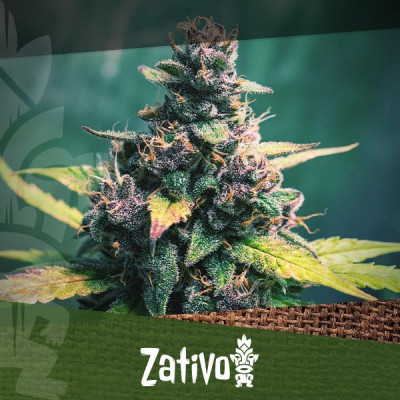Don't have an account?
Register NowYou have to add to cart at least 5 bottles or any program to make checkout.
- BlogWhy Does Cannabis Turn Purple?
Why Does Cannabis Turn Purple?
Published: April 20th, 2023
Categories:
Cannabis Cultivation
No, you’re not too high—your plants really are becoming more purple as the flowering stage progresses. But why does this happen? Below, you'll learn everything you need to know about purple cannabis, including what causes it and which strains are most likely to possess this trait.
What Is Purple Cannabis?
Most people associate cannabis with the colour green. And indeed, most strains produce green leaves and buds as they mature. However, occasionally, you’ll see purple cannabis plants pop up on social media, or even in your friend's grow room or garden. While they look rare and exotic, purple cannabis plants aren’t much different from their green counterparts. They produce similar compounds and offer similar psychoactive effects.
This striking difference in appearance simply stems from pigments present within the tissues of certain specimens. Simply put, green cannabis plants have a high chlorophyll content and therefore reflect green light. Purple cannabis plants possess chlorophyll too, but they also contain pigments that bounce back purple wavelengths of light.
Why Does Weed Become Purple?
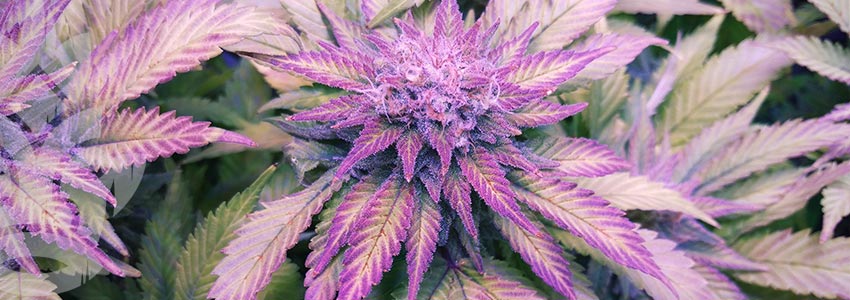
Have you ever transitioned your weed plants into bloom and wondered: "Why are my leaves turning purple during flowering?". While it might seem alarming at first, this phenomenon results from the expression of certain pigments—it’s nothing to worry about. These chemicals, known as anthocyanins, are the same phytochemicals responsible for the deep red, purple, and blue hues of blueberries, red cabbage, eggplant, and strawberries. Anthocyanins are present in all cannabis varieties, but they only become visible to the human eye when they occur in high quantities.
When enough anthocyanins become concentrated in leaf and flower tissue, the purple and reddish light that they reflect masks the green light reflected by chlorophyll molecules. In terms of their occurrence, anthocyanin levels are chiefly determined by the genetics of a particular strain, as well as specific environmental variables (more on this below).
Which Parts of the Plant Turn Purple?
Different parts of the cannabis plant can turn purple, depending on the stain in question. Some varieties turn almost entirely purple, whereas others display subtle hues on particular parts of their anatomy. Overall, the parts of a cannabis plant that can turn purple include:
- Buds: These structures are bundles of smaller pistillate flowers. In some strains, the buds turn completely purple, which contrasts beautifully with a layer of frosty white trichomes.
- Bracts: These are the small casings that make up pistillate flowers, and from which two tendril-like stigmata emerge. They’re also capable of turning purple in strains with high anthocyanin expression.
- Fan leaves: These are the larger leaves found on cannabis plants. As biological solar panels, they do most of the work when it comes to photosynthesis. However, high levels of anthocyanins can cause them to become completely purple.
- Sugar leaves: These are the smaller leaves found amongst the buds themselves. Here, they also contribute to photosynthesis, and thus flower development.
- Stems: Yep, even the stems can turn purple in some cannabis cultivars.
- Petioles: These are the smaller stems that connect individual fan leaves to branches. They’re known to turn purple and red.
What Are Anthocyanins?
Anthocyanins are a form of pigment found in plant tissues that play several important roles. Humans are drawn to healthy foods high in these compounds because of their antioxidant activity. In plants, anthocyanins are synthesised for the following purposes:
- Protection: Anthocyanins help to protect plants against UV radiation by reflecting these damaging wavelengths of light.
- Pollination: Because of their bright and attractive colour, anthocyanins help to attract pollinating insects.
- Growth: Anthocyanins contribute to the growth and development of plants in several ways, such as by promoting vertical growth and impairing lateral bud growth and development.
- Antioxidant activity: Just like in humans, anthocyanins help to neutralise free radicals in plants and prevent DNA damage.
- Defence: These colourful compounds also help to protect against diseases, including fungal pathogens.
How to Grow Purple Weed
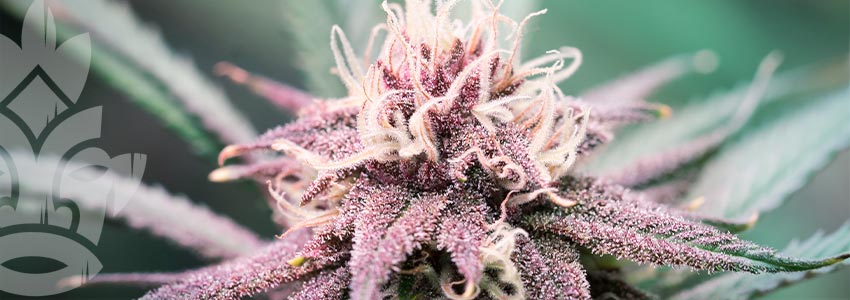
Many growers become enchanted by the sight of purple weed, and thus set out to grow it themselves. If you’re planning to grow some stunning purple buds in your grow room or garden, there are several things you need to know to increase your chances of success. Below, we cover three of the most important factors.
Pick the Right Strain
Genetics plays a key role when growing purple weed; some strains are wired to produce purple hues, even in the absence of other environmental variables. If you’re after some vibrant purple buds, then you can’t go wrong with these cultivars:
• Purple 1: As purple as purple gets, this beauty will stand out against every other plant in your growing space.
• Auto Purple: This stunning strain features dark purple hues emerging from the middle of her colas. With a speedy growing time of 9–10 weeks following sprouting, she ensures a rapid, high-quality yield.
• Purple Kush: These buds feature beautiful contrasting colours. The core of each bud is purple, while dark green sugar leaves decorate the exterior portion of the inflorescence.
Apply Temperature Stress
Temperature stress, both hot and cold, can help to bring out anthocyanin expression. Weed plants prefer to grow in a temperature range of 18–26°C. By pushing the boundaries by a couple of degrees Celsius on either side of this range, you’ll force your plant to produce more anthocyanins. You'll compromise plant performance to a degree, but you’ll have yourself a very purple reward.
Change pH Level
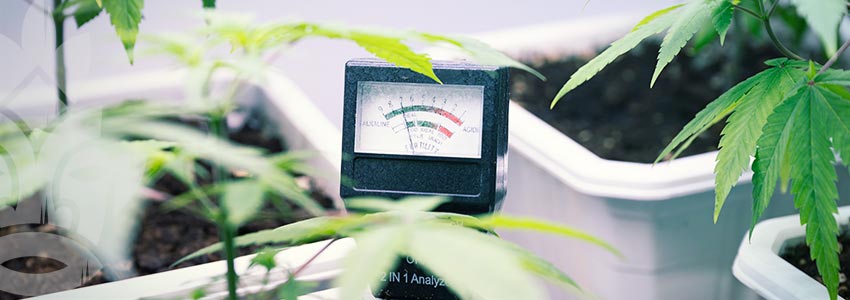
Cannabis plants thrive in a slightly acidic pH range of 5.5–6.0 during the vegetative phase and 6.0–6.5 during flowering. By lowering pH to 5.5–6.0 during bloom, you can help to tease out even more purple colours in strains that are capable of producing high levels of anthocyanins.
Is Purple Marijuana More Potent?
Not necessarily. Some purple strains possess far greater THC levels than some that remain green. However, the inverse is also true. High anthocyanin levels dictate physical appearance, but they don’t mean a cannabis strain will get you higher by default.
What Does Purple Weed Taste Like?
The aroma of a particular cannabis strain comes down to several different variables. Compounds such as terpenes and volatile sulphur compounds hold a large sway over how a plant smells and tastes. Adding to this, drying and curing the buds of any strain will increase their flavour and smoothness. While high concentrations of anthocyanins aren’t generally viewed as influential when it comes to flavour profile, they can add an element of bitterness to the mix.
Can Cannabis Turn Other Colours?
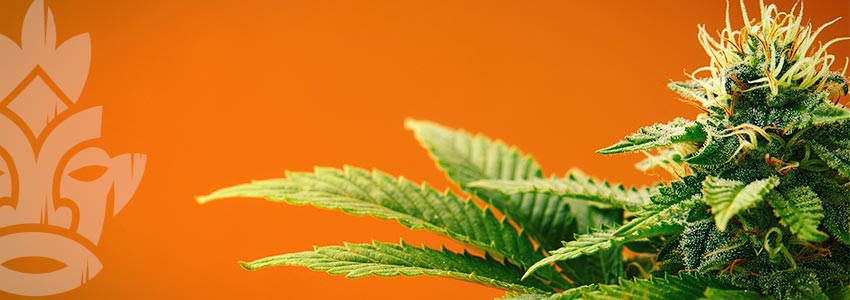
Yes! Cannabis plants churn out other phytochemicals that reflect different wavelengths of light. Molecules belonging to the carotenoid family (a group of terpenoid molecules) reflect red, yellow, and orange light. Although rare, cannabis strains with high concentrations of these chemicals can express these colours on their buds and leaves.
Purple Weed: A Feast for the Eyes
Now you are aware of why some cannabis plants turn purple, and which strains to grow if you want to experience this phenomenon for yourself. While this gorgeous trait doesn’t impact potency, and has little to no effect on taste, it certainly pleases the eyes—just watch the faces of your friends as you unveil your violet buds during a smoking session.

